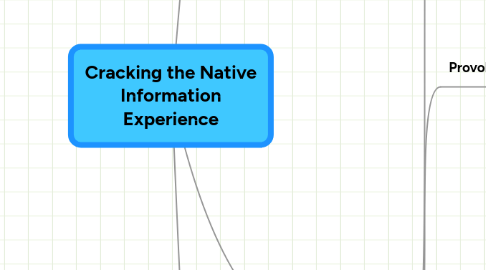
1. Introduction
1.1. Young Entrepreneur
1.1.1. What's Different
1.1.2. It is a new information environment that is
1.1.2.1. Networked
1.1.2.2. Digital
1.1.2.3. Abundant
1.1.2.4. Difficult to contain
1.1.2.4.1. And what of children who grow up with uncontainable information?
1.2. No Celling
1.3. Negroponte Quote
1.3.1. In spite of its inception as a tool for the august and older academic community, the average age of an Internet user today is 26 (a number derived with considerable care by MIT undergraduates Jonathan Litt and Craig Wisneski). I expect that number to drop to 15 by the year 2000.
2. Qualities of the NIE
2.1. Fueled by Questions
2.1.1. Ten Million Searches in August
2.1.1.1. Where were we asking those questions before Google?
2.1.2. Video Games
2.1.2.1. Assassin's Creed
2.1.2.2. Questions
2.1.2.2.1. How do I finish?
2.1.2.2.2. How do I accomplish the goal?
2.1.2.3. How did we ask those questions?
2.1.2.3.1. Find someone
2.1.2.3.2. Pick up a pen
2.1.2.3.3. Pick up the phone
2.1.2.3.4. Wait
2.1.2.4. They
2.1.2.4.1. Go Online
2.1.3. Increases in Broadband during recession
2.2. Provokes Communication
2.2.1. They are a Hyperconnected Species
2.2.2. Texting Surpasses Calls
2.2.2.1. Do you ever apologize for complete spelling & proper punctuation?
2.2.3. We feel Fine
2.2.4. Faces Activity
2.2.5. Pyramid Story
2.2.6. Facebook Statistics
2.2.7. Scratch
2.2.7.1. The Software
2.2.7.2. The Community (story)
2.2.8. Teen Texting Grows
2.2.9. Guest Network in Edmonton
2.2.9.1. The Portal
2.2.9.2. Statistics
2.3. Responsive
2.3.1. Old Notions of Responsiveness
2.3.1.1. Mathblaster
2.3.1.2. New Phonebook
2.3.1.2.1. The Video
2.3.1.2.2. The Blog
2.3.2. New Notions of Responsiveness
2.3.2.1. Community
2.3.2.2. Conversation
2.3.2.3. Blogging
2.3.2.3.1. Blogging Quotes
2.3.3. About Boundaries & Finding Traction
2.3.3.1. Old Days
2.3.3.1.1. Textbook
2.3.3.1.2. Chalk Board
2.3.3.1.3. Teacher
2.3.3.1.4. Tests
2.3.3.1.5. School Schedule
2.3.3.2. New Days
2.3.3.2.1. Classmates
2.3.3.2.2. Remote Students
2.3.3.2.3. Community
2.4. Demands Personal Investment
2.4.1. Gold Farming
2.4.2. Students making their own Lab Manuals
2.4.3. Students creating political parties
2.4.4. Othello Story
2.4.5. Bus.Tops
2.4.6. Making & Selling in Second Life
2.4.7. Darren Kuropatwa's Student Scribes
2.4.8. Student Creating own Textbooks - http://1ppx.sl.pt
2.5. Safely Made Mistakes
2.5.1. Making a Kilt in Second Life
2.5.2. Maine Guy in Second Life
2.5.2.1. Second Life Economy
2.5.3. The learn by failing
3. Hacking the NIE
3.1. Fueled by Questions
3.1.1. How am I assessing the learning & the lesson based on their questions as well as on their answers?
3.2. Provokes Communication
3.2.1. How does the assignment require the students to rely on each other to fulfile the goals?
3.3. Responsive
3.3.1. How does the assignment talk back?
3.3.1.1. The New Textbook
3.4. Demands Personal Investment
3.4.1. Where is the authentic value of the work & what does it mean to the learner from the learner's point of view?
3.5. Safely Made Mistakes
3.5.1. How am I assessing the learning and the lesson based on valuable mistakes?
